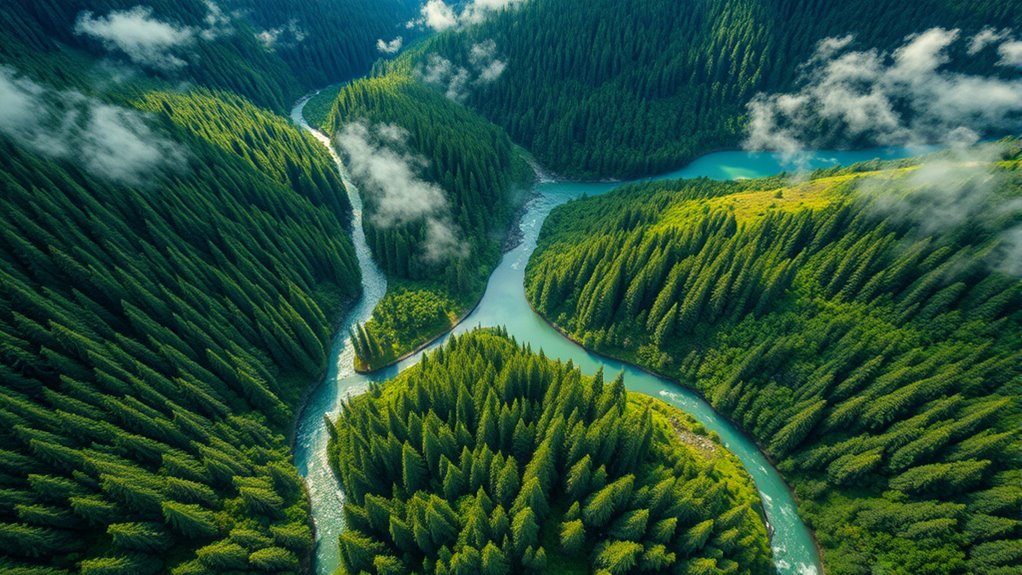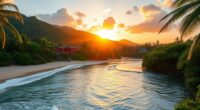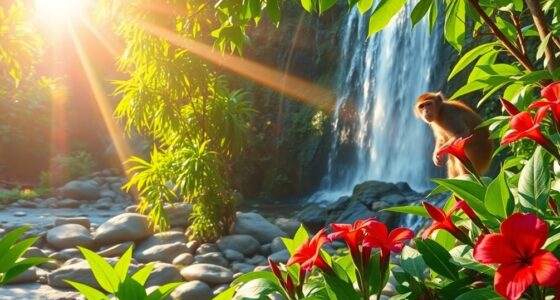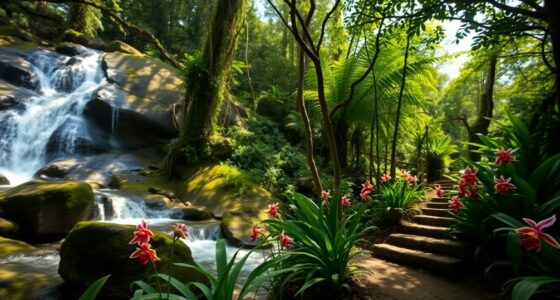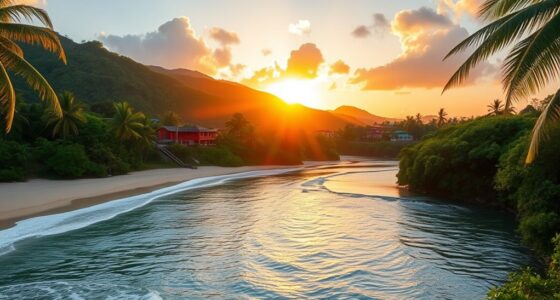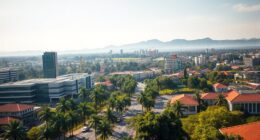Vancouver Island’s biosphere reserves protect diverse ecosystems, rich wildlife, and Indigenous cultural heritage. These areas feature wetlands, coastal habitats, rainforests, and crucial species like bald eagles, Pacific salmon, and Vancouver Island marmots. Conservation efforts focus on habitat preservation, ecosystem resilience, and community involvement, including Indigenous stewardship and eco-tourism. By exploring these reserves, you’ll discover how natural and cultural resources are preserved for future generations—if you continue, you’ll learn even more about their importance and ongoing efforts.
Key Takeaways
- Vancouver Island’s biosphere reserves protect unique ecosystems, including temperate rainforests, wetlands, and coastal habitats.
- Indigenous communities play a vital role in stewardship, integrating traditional knowledge with conservation efforts.
- These reserves support diverse native species like Vancouver Island marmots, sea otters, and Pacific salmon.
- Eco-tourism and community-led programs promote sustainable development and cultural heritage preservation.
- Conservation strategies focus on habitat protection, ecosystem resilience, and addressing threats such as invasive species and climate change.
The Significance of Biosphere Reserves on Vancouver Island
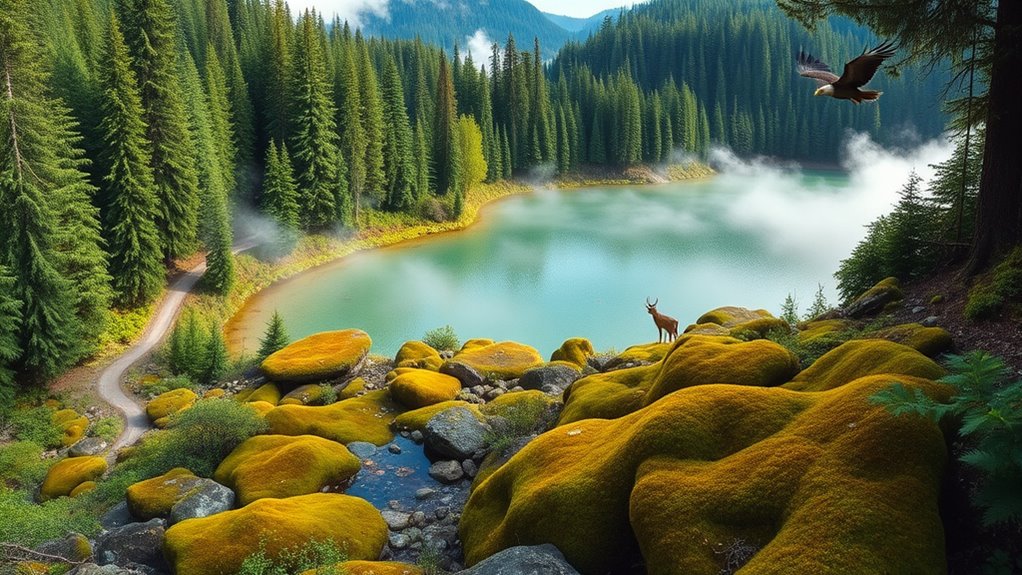
Biosphere reserves on Vancouver Island play a essential role in preserving the region’s unique ecosystems and promoting sustainable development. Their ecological importance is profound, safeguarding diverse habitats that support rare and endangered species. These reserves help maintain ecological balance, ensuring healthy forests, wetlands, and coastal environments. Beyond ecology, they hold deep cultural significance for Indigenous communities, who have relied on these lands for generations. The reserves serve as symbols of respect for traditional knowledge and spiritual connections to the land. By protecting these areas, we honor both nature and cultural heritage. Supporting biosphere reserves also contributes to conservation efforts, which are vital for maintaining biodiversity and ecological resilience. Your support ensures these crucial landscapes continue to thrive, providing ecological stability and cultural continuity for future generations. These reserves truly embody a harmonious blend of environmental and cultural preservation.
Key Ecosystems and Habitats Found in the Reserves
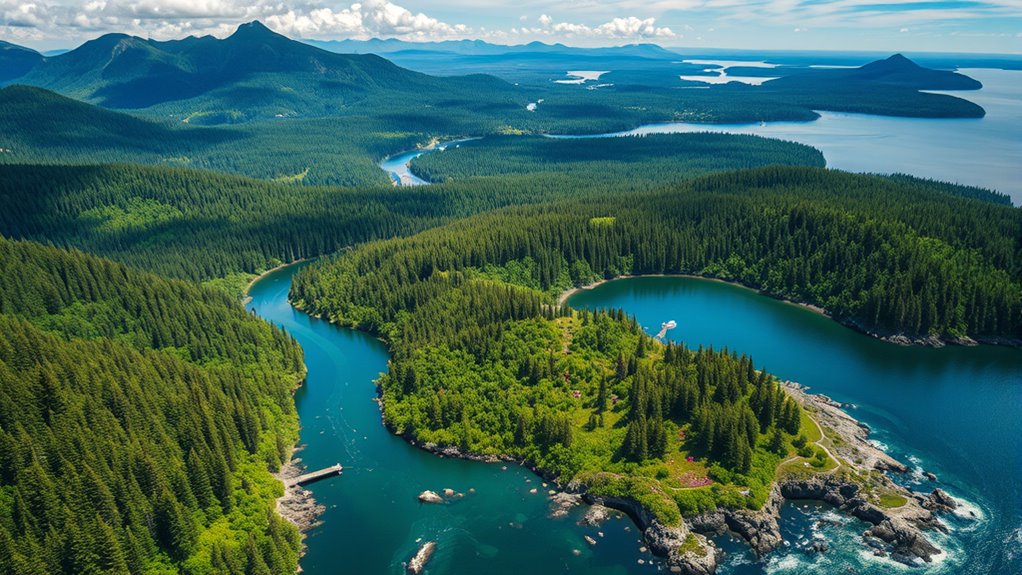
Vancouver Island’s biosphere reserves encompass a diverse array of ecosystems that are essential to the region’s ecological health. Wetland habitats are abundant, providing critical breeding grounds for birds, amphibians, and invertebrates. These wetlands also filter water, reduce flooding, and support plant diversity. Coastal ecosystems, including estuaries and rocky shores, are equally important. They serve as nurseries for fish, feeding grounds for migratory birds, and protect inland areas from storm surges. You’ll find these habitats teeming with life and indispensable for maintaining ecological balance. Protecting these key ecosystems guarantees the resilience of the region’s environment, supporting both biodiversity and local communities that depend on healthy natural resources. Their preservation is fundamental for sustaining Vancouver Island’s unique ecological landscape. Additionally, the diverse types of ecosystems found within the reserves contribute to a rich tapestry of biodiversity, ensuring ecological stability and resilience.
Notable Biosphere Reserves and Their Unique Features
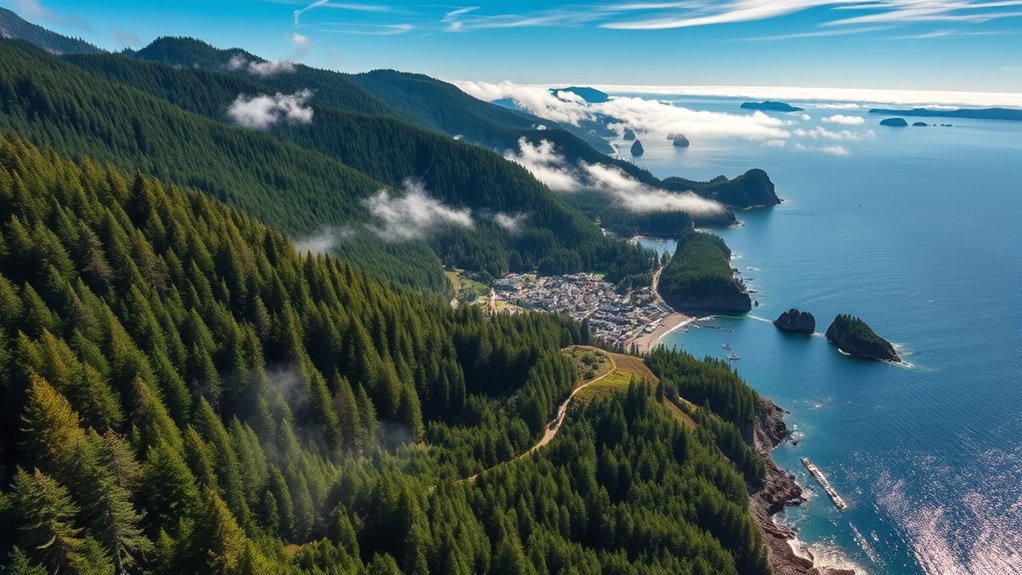
Among the most notable reserves is the Clayoquot Sound Biosphere Reserve, renowned for its temperate rainforests and rich marine life. This reserve highlights indigenous stewardship, as local First Nations actively manage and protect the land and waters, ensuring sustainable practices. The area offers excellent eco tourism opportunities, allowing visitors to experience pristine environments while supporting conservation efforts. You can explore guided rainforest walks, whale watching tours, and kayaking adventures that promote awareness of the region’s ecological significance. Clayoquot Sound exemplifies how indigenous knowledge and modern conservation can work together, creating a model for sustainable tourism. Its unique features draw nature enthusiasts and cultural explorers alike, making it a standout biosphere reserve on Vancouver Island. Additionally, the reserve’s conservation initiatives serve as a vital example of effective ecosystem management that benefits both biodiversity and local communities.
Flora and Fauna: Biodiversity Highlights
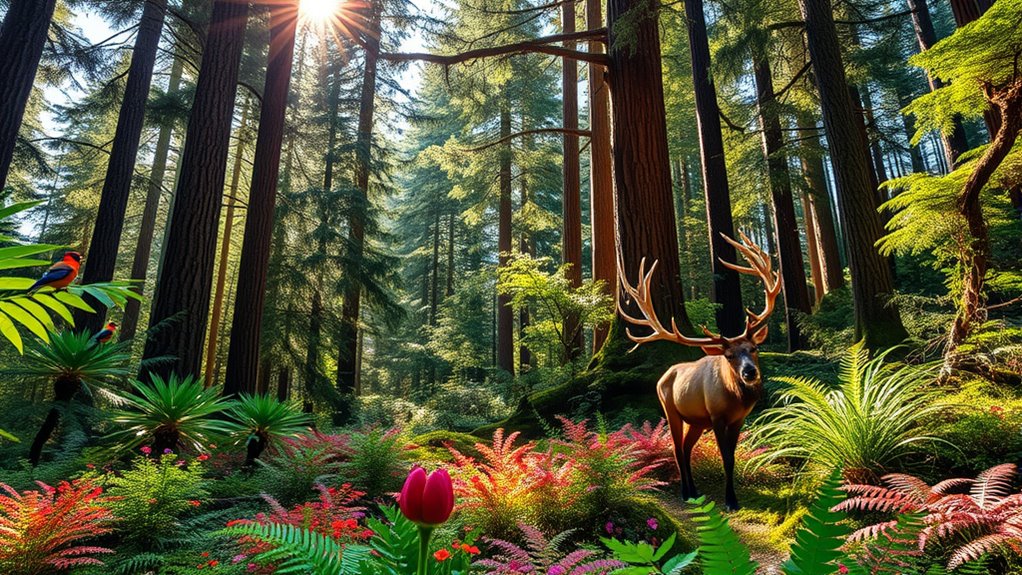
The diverse ecosystems within Vancouver Island’s biosphere reserves support an astonishing array of plant and animal species. You’ll find vibrant native species like the Vancouver Island marmot, black bears, and Douglas fir trees. However, invasive plants such as Himalayan blackberry and Scotch broom threaten this delicate balance, competing with native flora. To illustrate, here’s a snapshot:
| Native Species | Invasive Plants | Notable Animals |
|---|---|---|
| Vancouver Island Marmot | Himalayan Blackberry | Black Bears |
| Western Red Cedar | Scotch Broom | Roosevelt Elk |
| Douglas Fir | English Ivy | Bald Eagles |
| Sitka Spruce | Himalayan Knotweed | Sea Otters |
| Red Alder | Himalayan Honeysuckle | Pacific Salmon |
Protecting native species is essential to preserving biodiversity on Vancouver Island. Biodiversity conservation plays a crucial role in maintaining this ecological balance.
Conservation Strategies and Challenges
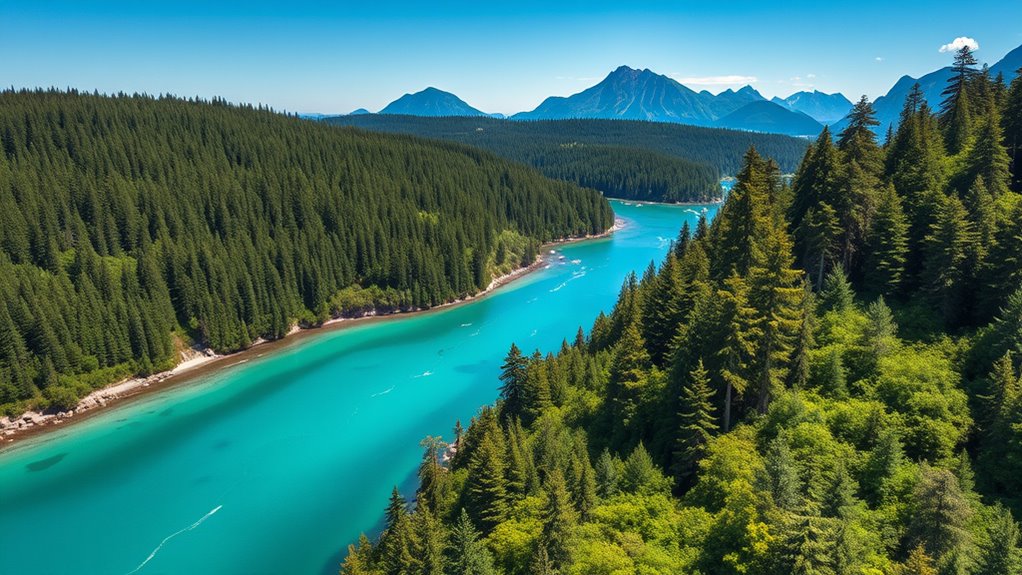
You need to find effective ways to protect Vancouver Island’s biodiversity hotspots while managing human activities that threaten them. Addressing climate change adds another layer of complexity, impacting ecosystems and species resilience. Balancing conservation efforts with community needs remains one of the biggest challenges you’ll face. Implementing conservation strategies for ecosystems that incorporate sustainable development practices can help address these issues effectively.
Protecting Biodiversity Hotspots
Protecting biodiversity hotspots on Vancouver Island requires targeted conservation strategies that address the unique threats these areas face. You need to prioritize preserving ecosystem services, such as clean water, air, and habitat stability, which are essential for both nature and local communities. Indigenous stewardship plays a critical role, as Indigenous peoples have managed these landscapes sustainably for generations. Their traditional knowledge helps identify sensitive areas and develop effective protection measures. Challenges include habitat loss from development and climate change, which threaten species diversity and ecological health. By supporting Indigenous-led initiatives and focusing on ecosystem resilience, you can help guarantee these hotspots remain vibrant and healthy. Active collaboration and respecting Indigenous rights are fundamental for safeguarding Vancouver Island’s rich biological heritage. Promoting biodiversity preservation efforts can further strengthen these initiatives and ensure long-term ecological balance.
Balancing Human Activities
Balancing human activities with conservation efforts on Vancouver Island requires careful planning and collaboration. You need to consider eco tourism development, which boosts local economies but can threaten ecosystems if unmanaged. Respect for Indigenous land rights is vital, ensuring their cultural and spiritual connections are preserved. To navigate these challenges, open dialogue between communities, governments, and stakeholders is essential. Here’s a quick look at key factors:
| Strategy | Challenge | Outcome |
|---|---|---|
| Eco tourism development | Overcrowding | Sustainable growth |
| Indigenous land rights | Land access conflicts | Respectful partnerships |
| Education programs | Lack of awareness | Increased conservation |
| Policy enforcement | Illegal activities | Protected habitats |
Additionally, incorporating crochet styles for locs and other protective styling methods can promote awareness and respect for cultural identities in conservation discussions.
Addressing Climate Impact
Vancouver Island’s rich ecosystems face increasing threats from climate change, which intensifies challenges in conserving its unique habitats. To address this, you can focus on enhancing carbon sequestration efforts by protecting forests and restoring wetlands, allowing natural systems to absorb more CO2. Promoting renewable energy sources, like wind and solar, reduces reliance on fossil fuels and cuts greenhouse gas emissions. Implementing these strategies helps mitigate climate impacts while supporting local communities. You can also support sustainable practices that prioritize ecosystem resilience, ensuring habitats stay healthy amid changing conditions. Balancing career and personal life is essential for maintaining environmental initiatives alongside community development. While challenges remain, integrating conservation with renewable energy initiatives offers a promising path forward. Your active involvement can make a tangible difference in safeguarding Vancouver Island’s climate and biodiversity for future generations.
Research and Educational Opportunities
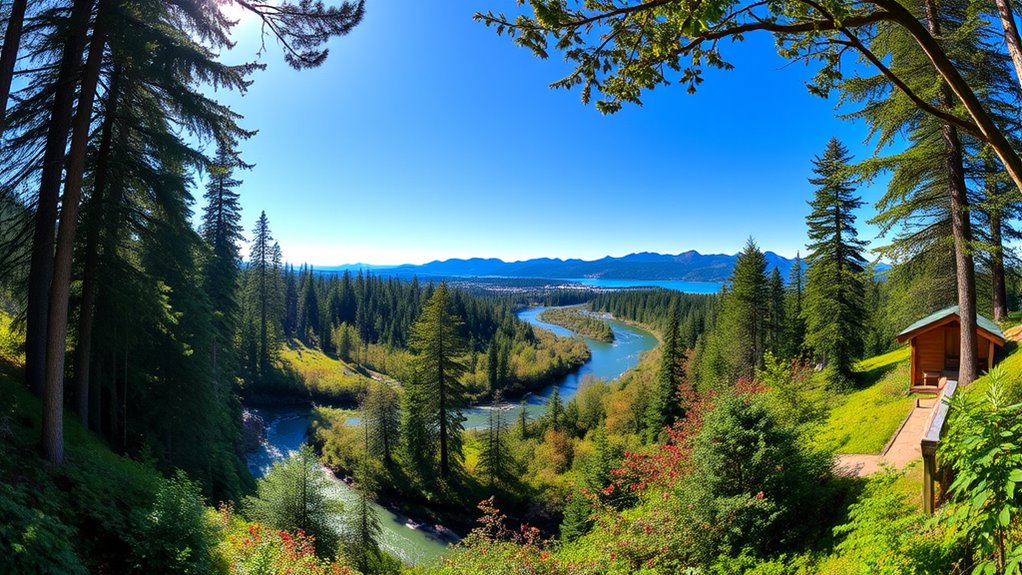
Have you ever wondered how biosphere reserves serve as living classrooms for students and researchers alike? These reserves offer unique research and educational opportunities that deepen understanding of ecosystems and conservation. You can participate in ecotourism initiatives that promote sustainable travel while studying local biodiversity firsthand. Schools and universities often organize field trips and hands-on projects focused on habitat restoration and species monitoring. Additionally, biosphere reserves support cultural heritage preservation by integrating traditional knowledge and practices into educational programs. This blend of science and culture enriches learning experiences and fosters respect for local communities. Regular monitoring and ecosystem management ensure the health and sustainability of these environments. Whether you’re a student seeking practical experience or a researcher aiming to gather data, these reserves provide an essential platform for advancing knowledge and promoting sustainable stewardship of the environment.
Community Engagement and Sustainable Practices
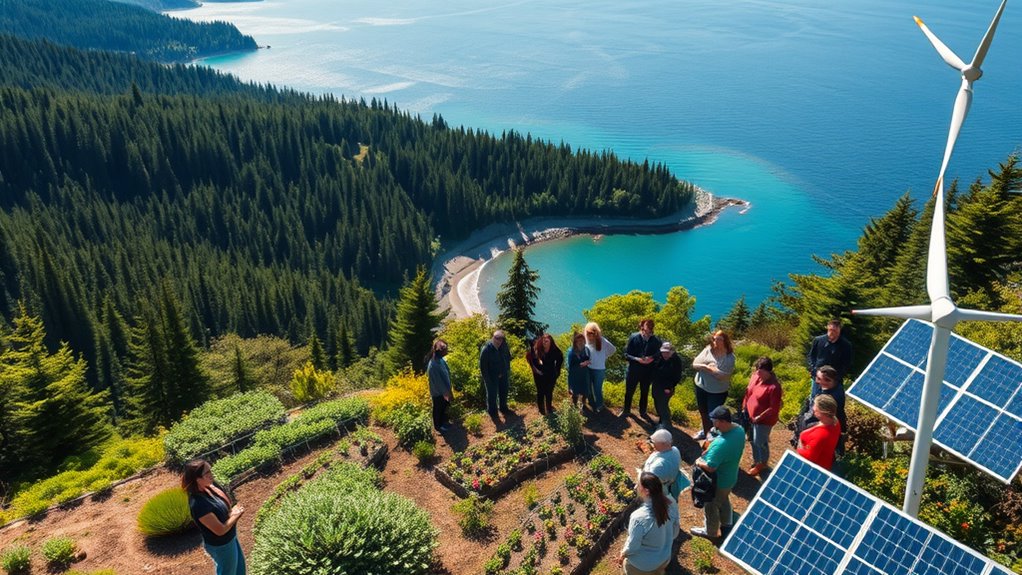
How do biosphere reserves foster meaningful community engagement and promote sustainable practices? They encourage local communities to participate actively in conservation through indigenous stewardship and eco-tourism initiatives. These reserves empower residents to preserve cultural heritage while managing natural resources responsibly. By involving Indigenous groups, reserves ensure traditional knowledge guides sustainable land use. Eco-tourism provides economic benefits and raises awareness about conservation efforts. You can take part in:
- Collaborating with Indigenous communities on stewardship projects
- Supporting eco-tourism businesses that prioritize sustainability
- Participating in community-led conservation programs
These practices foster a sense of ownership and responsibility, ensuring that preservation efforts benefit both the environment and local communities for future generations. Incorporating AI security technologies can also enhance monitoring and enforcement of conservation measures, making efforts more effective and safeguarding natural resources.
Visiting and Exploring Vancouver Island’s Biosphere Reserves
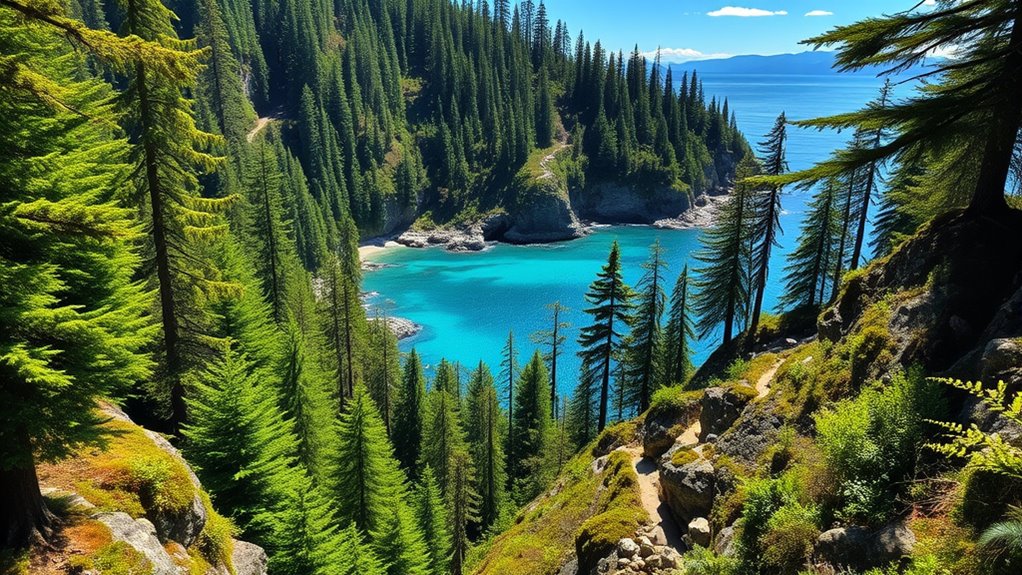
Exploring Vancouver Island’s biosphere reserves offers a unique opportunity to experience diverse ecosystems and cultural heritage firsthand. When you visit, you’ll find well-marked trails, interpretive signs, and guided tours that highlight the rich history of indigenous stewardship. Many reserves are managed in partnership with Indigenous communities, allowing you to learn about their cultural heritage and traditional practices. Respectful exploration lets you witness the landscapes they’ve nurtured for generations. You can participate in cultural events or visit Indigenous-led centers to deepen your understanding. Traveling responsibly ensures these natural and cultural treasures remain vibrant for future generations. Whether hiking through lush forests or engaging with local Indigenous storytellers, your visit supports the preservation of Vancouver Island’s ecological and cultural legacy.
Frequently Asked Questions
How Do Biosphere Reserves Impact Local Indigenous Communities?
Biosphere reserves impact Indigenous communities by fostering Indigenous stewardship and promoting cultural preservation. You’re involved in protecting natural landscapes while respecting traditional knowledge and practices. This collaboration helps conserve cultural heritage and ensures Indigenous voices guide conservation efforts. As a result, these reserves support sustainable development that honors Indigenous traditions, empowering communities to maintain their way of life, pass down cultural practices, and strengthen their connection to the land for future generations.
What Are the Long-Term Ecological Benefits of These Reserves?
You’ll see that these reserves bolster long-term ecological health by enhancing ecosystem resilience and promoting biodiversity preservation. They protect diverse habitats, allowing species to thrive and adapt to environmental changes. Over time, this strengthens ecosystems’ ability to recover from disturbances like climate shifts or pollution. By maintaining healthy, balanced ecosystems, these reserves ensure sustainable resources and a resilient environment for future generations.
Are There Any Endangered Species Specific to Vancouver Island’s Reserves?
Did you know that over 150 species are at risk of extinction in this area? You’ll find several endangered species, like the Vancouver Island marmot and the marbled murrelet, that benefit from species conservation and habitat preservation efforts. These reserves play a essential role in protecting their habitats, ensuring these unique creatures survive. Your support helps maintain healthy ecosystems and safeguards the island’s rich biodiversity for future generations.
How Do Biosphere Reserves Adapt to Climate Change Challenges?
You can enhance climate resilience by implementing adaptive management strategies that respond to changing conditions. This involves monitoring environmental shifts, adjusting conservation efforts, and engaging local communities. By staying flexible and data-driven, you help protect ecosystems from climate change impacts. Adaptive management guarantees your actions remain effective over time, fostering resilience and preserving biodiversity for future generations. This proactive approach is essential in addressing the uncertainties of climate change.
What Funding Sources Support Conservation Efforts on Vancouver Island?
You can access various funding sources to support conservation efforts, including government grants that fund environmental projects and ecotourism funding that promotes sustainable travel. These funds help protect natural habitats and promote awareness. By applying for government grants, you can secure essential financial support, while ecotourism revenue can be reinvested into conservation programs. Together, these sources provide crucial resources to sustain and expand your conservation initiatives.
Conclusion
Imagine stepping into Vancouver Island’s biosphere reserves, where vibrant ecosystems weave a tapestry of life, each thread essential and unique. These protected areas aren’t just snapshots of nature—they’re the heartbeat of the island’s future. By exploring and conserving these reserves, you become part of a living mural, ensuring that future generations can marvel at this lush paradise. Embrace your role as a steward, and help keep this breathtaking masterpiece thriving.

